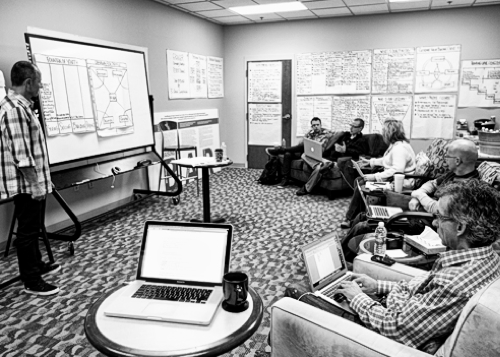 Over the last few years, I have enjoyed learning more and more from the contribution of Tom Paterson. Tom is a brilliant consultant and friend of Peter Drucker who innovated a very specific, high-impact model of strategic planning in the business space. I am grateful for five gentleman who have been a part of my own access and "digestion" of StratOps as a certified facilitator : Doug Slaybough (pictured above & former guy beyond the success of Rick Warren's Purpose Driven organization), Michael Murphy (current president of the Paterson Center), Greg Hawkins (executive pastor of Willow Creek Community Church), Buck Rogers (friend and master facilitator) and Todd Wilson (kindgom entrepreneur behind Exponential and a fellow clarity junkie).
Over the last few years, I have enjoyed learning more and more from the contribution of Tom Paterson. Tom is a brilliant consultant and friend of Peter Drucker who innovated a very specific, high-impact model of strategic planning in the business space. I am grateful for five gentleman who have been a part of my own access and "digestion" of StratOps as a certified facilitator : Doug Slaybough (pictured above & former guy beyond the success of Rick Warren's Purpose Driven organization), Michael Murphy (current president of the Paterson Center), Greg Hawkins (executive pastor of Willow Creek Community Church), Buck Rogers (friend and master facilitator) and Todd Wilson (kindgom entrepreneur behind Exponential and a fellow clarity junkie).Most recently, I have completed the integration work of utilizing Paterson's StratOp process for churches as a follow-up to Vision Pathway process that I have developed and used for twelve years, through the ministry of Auxano.
Why?
Simply put, The Vision Pathway and StratOps are the two best ways to solve two different but related problems for the local church leaders.
In this post I want to explore the basic differences. In the rest of a series I want to show:
- Part 2: The REAL Chemistry of Vision Pathway and StratOps
- Part 3: Why StratOps is a Waste of Time if You Don't Have a Vision Frame
- Part 4: Why Every Church over 400 in Attendance Should Use StratOps
VISION PATHWAY AS A UNIQUE SOLUTION
The Vision Pathway was created to solve the problem of cut-n-paste ministry models and photocopied vision proliferated by books and conference in the church space. The result is a lack of freedom, confidence, passion, credibility and ultimately progress for a local church leadership team.
The Vision Pathway was developed in 2001-2004 from a biblical understanding of the church in order to develop new competencies in thinking, leadership and communication for local church teams. The deliverable of the process is a fully articulated vision and ministry model that takes into account a church's heritage, the unique community context, the distinctive congregational strengths and Spirit-guided passion of the leadership. The process was formally articulated in the book, Church Unique in 2008 with the subtitle of "How Missional Leaders Cast Vision, Capture Culture and Create Movement." Church Unique continues to be the leading book in the church vision and planning category since it's publication.
The baseline Vision Pathway requires a minimum of 6 days of collaborative work over a several month period. The Pathway is built with 5 master tools, that cover 8 big ideas, with 10 specific deliverables with dozens of "add-on" features and optional sub-tools based on church's theological bent, size, life-stage, growth challenges and culture. There really is no other comparable process for church leaders to experience.
STRAT-OPS AS A UNIQUE SOLUTION
StratOps was created to solve the problem of lengthy strategic planning process that don't get total buy in across the executive team of large businesses. The result is a lack of daily cooperation and coordination of diverse functional units towards the strategy priorities of the business.
StratOp was birthed through a challenge in 1980 issued to Tom Paterson to reduce the timeframe and increase the effectiveness of formal strategic planning. The design parameter was three days, which was given to Patersonby Thomas E. Bennett, who was the the Vice President for Corporate Planning for Ingersol-Rand Company. The content of the process is available only through the Paterson Center to certified consultants and facilitators. (Approximately 180 have gone through the process in the last 15 years.)
The StratOps process is a 3-day event (with a typical 2-day follow-up process with key individual leaders). It works through 25 "tools" that are collaborative conversations ranging from 30 minutes to 2 hours. The deliverable is a set of dashboard-like documents that can be used in the operational flow of leadership and management. While there are many planning processes out there, I have not seen one better for creating priorities within a one-year horizon. In addition several Paterson disciples are Jesus-followers who have applied what was originally designed for business, to the local church.
